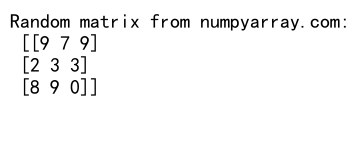NumPy随机整数生成:全面掌握numpy.random模块的整数生成功能
NumPy是Python中用于科学计算的核心库之一,其中的random模块提供了强大的随机数生成功能。本文将深入探讨NumPy中随机整数生成的各种方法和技巧,帮助您全面掌握这一重要功能。
1. NumPy random模块简介
NumPy的random模块是一个功能丰富的随机数生成工具,它不仅可以生成各种分布的随机数,还可以进行随机抽样、随机排列等操作。在本文中,我们将重点关注随机整数的生成。
首先,让我们导入所需的模块:
import numpy as np
2. 生成单个随机整数
2.1 使用randint()函数
randint()函数是生成随机整数最常用的方法之一。它可以生成指定范围内的随机整数。
import numpy as np
# 生成0到10之间的随机整数
random_int = np.random.randint(0, 11)
print("Random integer from numpyarray.com:", random_int)
Output:

在这个例子中,我们生成了一个0到10之间的随机整数。注意,上限11是不包括在内的。
2.2 使用random_integers()函数(已弃用)
random_integers()函数曾经是另一个生成随机整数的选择,但现在已经被弃用。它的行为与randint()略有不同,包括上限。
import numpy as np
# 生成1到10之间的随机整数(包括10)
random_int = np.random.random_integers(1, 10)
print("Random integer from numpyarray.com:", random_int)
虽然这个函数仍然可以使用,但建议使用randint()来代替。
3. 生成随机整数数组
3.1 使用randint()生成数组
randint()函数不仅可以生成单个随机整数,还可以生成随机整数数组。
import numpy as np
# 生成5个0到100之间的随机整数数组
random_array = np.random.randint(0, 101, size=5)
print("Random array from numpyarray.com:", random_array)
Output:

这个例子生成了一个包含5个0到100之间随机整数的数组。
3.2 指定数组形状
我们还可以指定生成的随机整数数组的形状:
import numpy as np
# 生成一个3x3的随机整数矩阵,范围是0到9
random_matrix = np.random.randint(0, 10, size=(3, 3))
print("Random matrix from numpyarray.com:\n", random_matrix)
Output:

这个例子生成了一个3×3的随机整数矩阵,每个元素的范围是0到9。
4. 设置随机种子
为了确保随机数的可重复性,我们可以设置随机种子。这在进行科学实验或调试时特别有用。
import numpy as np
# 设置随机种子
np.random.seed(42)
# 生成随机整数
random_int = np.random.randint(0, 100)
print("Random integer from numpyarray.com with seed:", random_int)
Output:

在这个例子中,我们设置了随机种子为42。每次运行这段代码时,都会生成相同的”随机”整数。
5. 生成特定分布的随机整数
5.1 均匀分布
默认情况下,randint()生成的是均匀分布的随机整数。这意味着每个整数被选中的概率是相等的。
import numpy as np
# 生成1000个0到9之间的随机整数
uniform_ints = np.random.randint(0, 10, size=1000)
print("Uniform distribution from numpyarray.com:", np.unique(uniform_ints, return_counts=True))
Output:

这个例子生成了1000个0到9之间的随机整数,并统计了每个数字出现的次数。理论上,每个数字应该出现大约100次。
5.2 二项分布
二项分布是一种离散概率分布,表示n次独立的是/否试验中成功的次数。
import numpy as np
# 生成1000个二项分布的随机整数,n=10,p=0.5
binomial_ints = np.random.binomial(n=10, p=0.5, size=1000)
print("Binomial distribution from numpyarray.com:", np.unique(binomial_ints, return_counts=True))
Output:

这个例子模拟了1000次投掷10枚硬币的实验,每个数字表示一次实验中正面朝上的硬币数量。
5.3 泊松分布
泊松分布是一种离散概率分布,表示单位时间内随机事件发生的次数。
import numpy as np
# 生成1000个泊松分布的随机整数,lambda=3
poisson_ints = np.random.poisson(lam=3, size=1000)
print("Poisson distribution from numpyarray.com:", np.unique(poisson_ints, return_counts=True))
Output:

这个例子生成了1000个服从泊松分布的随机整数,其中λ(lambda)参数为3。
6. 随机整数的应用
6.1 随机抽样
随机整数生成在随机抽样中有广泛的应用。例如,我们可以从一个数组中随机选择元素:
import numpy as np
# 从给定数组中随机选择元素
array = np.array([1, 2, 3, 4, 5])
random_choice = np.random.choice(array, size=3, replace=False)
print("Random choice from numpyarray.com:", random_choice)
Output:

这个例子从数组[1, 2, 3, 4, 5]中随机选择3个不重复的元素。
6.2 随机打乱数组
我们还可以使用随机整数来打乱数组的顺序:
import numpy as np
# 随机打乱数组
array = np.arange(10)
np.random.shuffle(array)
print("Shuffled array from numpyarray.com:", array)
Output:

这个例子创建了一个0到9的数组,然后随机打乱了它的顺序。
6.3 生成随机索引
随机整数也可以用来生成随机索引,这在数据处理中非常有用:
import numpy as np
# 生成随机索引
data = np.array(['a', 'b', 'c', 'd', 'e'])
random_indices = np.random.randint(0, len(data), size=3)
random_elements = data[random_indices]
print("Random elements from numpyarray.com:", random_elements)
Output:

这个例子从数组中随机选择3个元素,通过生成随机索引来实现。
7. 高级技巧
7.1 生成不重复的随机整数
有时我们需要生成一组不重复的随机整数。虽然NumPy没有直接提供这个功能,但我们可以通过组合使用其他函数来实现:
import numpy as np
# 生成不重复的随机整数
unique_ints = np.random.choice(100, size=10, replace=False)
print("Unique random integers from numpyarray.com:", unique_ints)
Output:

这个例子生成了10个0到99之间不重复的随机整数。
7.2 生成加权随机整数
在某些情况下,我们可能需要生成加权的随机整数,即某些数字被选中的概率更高:
import numpy as np
# 生成加权随机整数
values = np.array([0, 1, 2, 3, 4])
weights = np.array([0.1, 0.2, 0.3, 0.2, 0.2])
weighted_random = np.random.choice(values, size=1000, p=weights)
print("Weighted random integers from numpyarray.com:", np.unique(weighted_random, return_counts=True))
Output:

这个例子生成了1000个加权随机整数,其中2被选中的概率最高(30%)。
7.3 生成指定范围内的随机整数数组
有时我们需要生成一个随机整数数组,其中每个元素都在不同的范围内:
import numpy as np
# 生成指定范围内的随机整数数组
low = np.array([0, 10, 20])
high = np.array([10, 20, 30])
random_array = np.random.randint(low, high, size=(3, 3))
print("Random array with specified ranges from numpyarray.com:\n", random_array)
Output:

这个例子生成了一个3×3的随机整数数组,其中第一行的元素在0到9之间,第二行在10到19之间,第三行在20到29之间。
8. 性能考虑
在处理大量随机整数时,性能可能会成为一个问题。NumPy的随机数生成器是经过优化的,通常比Python的内置random模块快得多。然而,还有一些技巧可以进一步提高性能:
8.1 使用向量化操作
尽可能使用NumPy的向量化操作,而不是Python的循环:
import numpy as np
# 使用向量化操作生成随机整数数组
size = 1000000
random_array = np.random.randint(0, 100, size=size)
print("Random array size from numpyarray.com:", len(random_array))
Output:

这个例子一次性生成了一百万个随机整数,比使用循环逐个生成要快得多。
8.2 使用适当的数据类型
根据需要生成的随机整数范围,选择适当的数据类型可以节省内存并提高性能:
import numpy as np
# 使用适当的数据类型
random_array = np.random.randint(0, 256, size=1000000, dtype=np.uint8)
print("Random array dtype from numpyarray.com:", random_array.dtype)
Output:

这个例子生成了一百万个0到255之间的随机整数,使用了8位无符号整数类型(uint8),这比默认的64位整数类型节省了大量内存。
9. 常见问题和解决方案
在使用NumPy生成随机整数时,可能会遇到一些常见问题。以下是一些问题及其解决方案:
9.1 生成的随机数不够随机
如果发现生成的随机数似乎不够随机,可能是因为使用了固定的随机种子或者没有正确初始化随机数生成器。解决方法是使用当前时间作为种子:
import numpy as np
# 使用当前时间作为随机种子
np.random.seed(int(time.time()))
random_int = np.random.randint(0, 100)
print("Random integer with time seed from numpyarray.com:", random_int)
这个例子使用当前时间作为随机种子,每次运行都会得到不同的结果。
9.2 生成的随机数范围不正确
有时可能会发现生成的随机数超出了预期的范围。这通常是因为误解了randint()函数的参数。记住,randint(low, high)生成的是[low, high)范围内的整数,不包括high。
import numpy as np
# 正确使用randint()函数
random_int = np.random.randint(1, 11) # 生成1到10之间的随机整数
print("Random integer in correct range from numpyarray.com:", random_int)
Output:

这个例子正确地生成了1到10之间的随机整数。
9.3 随机数生成速度慢
如果发现随机数生成速度慢,特别是在生成大量随机数时,可以考虑使用NumPy的并行随机数生成功能:
import numpy as np
# 使用并行随机数生成
from numpy.random import default_rng
rng = default_rng()
random_array = rng.integers(0, 100, size=1000000)
print("Random array size using parallel generation from numpyarray.com:", len(random_array))
Output:

这个例子使用了NumPy的新随机数生成器接口,它支持并行生成,可以在多核系统上提高性能。
10. 总结
NumPy的random模块为生成随机整数提供了强大而灵活的工具。从简单的单个随机整数到复杂的多维随机整数数组,从均匀分布到各种特殊分布,NumPy都能满足各种需求。通过本文的详细介绍和示例,您应该能够熟练运用NumPy的随机整数生成功能,并在实际项目中灵活应用。
记住,随机数生成在科学计算、统计分析、机器学习等领域都有广泛的应用。掌握这些技能将帮助您更好地处理各种数据分析和模拟任务。同时,也要注意随机数生成的性能问题,特别是在处理大规模数据时。
 极客教程
极客教程